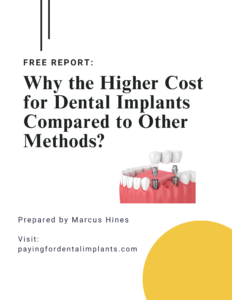Physical Address
12245 Cypress Spring Road, Clarksburg, MD 20871
Physical Address
12245 Cypress Spring Road, Clarksburg, MD 20871

Last updated on April 1st, 2025 at 11:55 pm
Dental implants are the most effective long-term solution for replacing missing teeth. They offer a durable and natural-looking replacement. However, they can be costly, and while dental insurance can help, it often covers only a small portion of the expense. In this post, we’ll explore how dental insurance works for implant procedures, its limitations, and additional ways to manage the costs.
Whether or not dental insurance will cover dental implant procedures is a subjective matter. The truth is some insurance companies will cover a portion of an implant procedure, others won’t.
Unfortunately, a large percentage of insurance companies still classify this procedure as “cosmetic” since there are traditional tooth replacement options like fixed-bridges and partial dentures. It is always wise to consider your insurance options during open-enrollment. This is the time to learn if either of your options provide implant coverage.
When dental insurances does offer coverage for this procedure, it is usual considered a “Major” procedure. Major procedures are usually covered at 50% of the cost of a procedure, up to the annual maximum amount, less the deductible.
Some insurance companies will offer coverage for the implant crown only, but not the implant surgery. As in the following example, when a dental insurance policy comes with a $1,500 annual maximum, and offers cover for the implant crown only, the patient can expect the implant to be covered similarly:
Based on this example, it is not unusual to expect a typical dental insurance to cover about $725 for a dental implant procedure. If the insurance company offers coverage for the implant crown and surgery, the amount covered may increase.
Either way, the patient will need to pay the “out of pocket” difference of $4,500 in this case. This is one important reason why patients who wisely choose to receive dental implants don’t base their decision on dental insurance. Frequently implant patients seek other payment plan options to make their dental implant treatment affordable.
While the exact price can vary, a single dental implant typically costs between $3,000 and $5,000. A full arch dental implant procedure can cost significantly more. Understanding the cost of dental implants can help put insurance coverage in perspective.
A single dental implant cost includes the implant itself, the abutment, and the crown. Here is the average cost breakdown:
It should be understood that dental insurance, in most cases, will only cover a fraction of the overall cost. If multiple implants are required, the percentage of the total cost covered by dental insurance, is even less.
Regardless, replacing a missing tooth with a dental implant offers a profound long-term advantage over any other alternative. Therefore, it is always wise to seek methods that will allow for implant treatment affordability, regardless of dental insurance involvement.
Many dental insurance plans have annual maximums, often ranging between $1,000 and $2,000. This means that even with full coverage, the maximum amount your insurance will pay toward any dental procedure each year is capped at this amount.
Since dental implants are typically classified as a “major” procedure, they are only partially covered by insurance, and the annual maximum of $1,000 or $2,000 is quickly met. For a comprehensive treatment plan that may cost several thousand dollars, these annual limits may be a drop in the bucket.
Most insurance plans will pay about 50% of the cost of major procedures, like dental implants — after the deductible is met. This split payment can be helpful but is generally limited by the yearly maximum.
For example, if the fee for your implant is $4,532 — as in the previous section — your insurance might cover 50% of the total cost, minus the $50 deductible. Keep in mind this 50% is only be up to your annual maximum amount of $1,500. In this case, it will be necessary to seek out additional resources to pay the difference.
Dental insurance is generally considered most beneficial from a maintenance prospective, i.e. annual check ups, routine cleanings, fillings and crowns. If you are considering in purchasing dental insurance, the MarketWatch Guides website is a great place to start.
Since insurance alone may not fully cover the expense of dental implants, it’s wise to consider other financing methods. After all, you may even be one of 68.5 million adults in the U.S. who don’t have dental insurance. Don’t allow this to block you from receiving implant treatment. Consider leveraging additional means cover your implant treatment.
Here are a few commonly used resources to consider:
Other options can be used in combination with dental insurance as well.
The very limited dental insurance annual maximum of $1,000 to $2,000 means dental insurance should not weigh heavy in your decision making process. Since implants are classified as a major procedure, insurance plans will cover only about 50%; this is after the deductible and capped off at the annual maximum.
Considering the average cost of a dental implant is between $3,000 and $5,000, additional financing options may be necessary to make your implant treatment accessible. Combining insurance benefits with alternative financing methods is usually necessary. Understanding this upfront helps patients to better navigate the financial side of implant procedures.
If you have dental insurance, do everything you can to maximize your benefits. However, it may not be worth purchasing dental insurance simply to offset the cost of your dental implant procedure.

This will close in 0 seconds
[…] on his wife’s plan. His wife’s dental insurance came with a $1,500 annual maximum. Visit our Dental Insurance page to learn more about how dental insurance coverage applies to implant […]